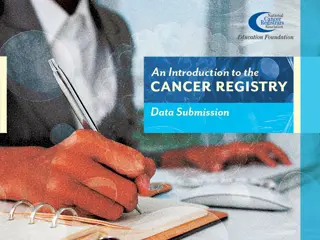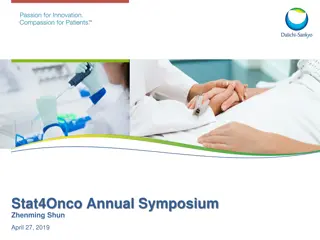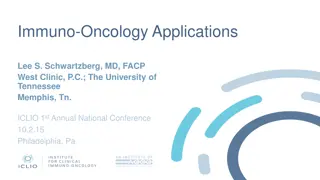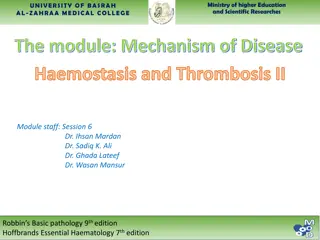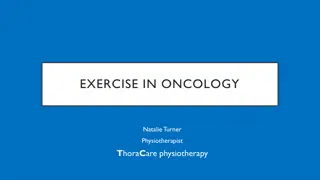Understanding Cancer-Associated Thrombosis for Oncology Clinicians
This presentation explores the common complications of cancer-associated thrombosis and its impact on cancer patients. It covers risk factors, management approaches, and individualized plans, emphasizing the importance of early identification and mitigation. The content also includes a case study highlighting a patient's journey through diagnosis and treatment.
Download Presentation

Please find below an Image/Link to download the presentation.
The content on the website is provided AS IS for your information and personal use only. It may not be sold, licensed, or shared on other websites without obtaining consent from the author. Download presentation by click this link. If you encounter any issues during the download, it is possible that the publisher has removed the file from their server.
E N D
Presentation Transcript
CANCER-ASSOCIATED THROMBOSIS FOR ONCOLOGY CLINICIANS Adrian Yee, MD, FRCPC, MET Hematologist, Victoria BC
LEARNING OBJECTIVES Identify risk factors and mitigate the risks. Develop a management approach. Develop an individualized management plan for patients in rural and remote regions. 20XX PRESENTATION TITLE 2
TERRITORIAL ACKNOWLEDGEMENT A VIEW OF FORT VICTORIA AS SEEN FROM THE SONGHEES VILLAGE, 1851. SKETCH BY LINTON PALMER. ROYAL GEOGRAPHIC SOCIETY PRESENTATION TITLE 3
CONFLICT OF INTEREST I declare no conflict of interest relevant to this presentation.
CANCER ASSOCIATED THROMBOSIS Common complications in patients with cancer; estimate ranging from 1% to 30%. Negatively affect mortality among cancer patients. Second leading cause of death in cancer patients. Hematology Am Soc Hematol Educ Program (2010) 2010 (1): 144 149. 20XX PRESENTATION TITLE 5
RISK FACTORS FOR VTE IN CANCER Risk varies from 1 30% depending on: Cancer-related Treatment-related Patient-related Primary site Histology Metastatic disease Time interval since diagnosis Surgery Chemotherapy Hormonal therapy Antiangiogenic therapy ESA Hospitalization Catheters Older age Prior VTE Platelet count Comorbid conditions Lyman et al. J Clin Oncol 2007.
CASE 1 A 47-year-old patient has a history of increasing abdominal bloating. CT was consistent with an adnexal mass. She has been referred to Gyne- Oncology for surgery due to the concern of ovarian/fallopian tube cancer. 20XX PRESENTATION TITLE 7
Venous Thromboembolism Risk Venous Thromboembolism Risk Risk of VTE Patient-related Risk Factors Courtesy of Dr. Agnes Lee 8
VTE RISK FACTORS Cancer-Related Patients/Context Metastatic disease Previous history of VTE Extreme Risk: Stomach, Pancreatic Obesity High Risk: Lung, Lymphoma, Post-operative (more than 45 minutes of Myeloma, Gynecologic, GU excluding General Anesthesia) prostate Thrombophilia Systemic Therapy: Bevacizumab, Abdominal surgery/Joint surgery Lenalidomide, Gemcitabine, Cisplatin, Tamoxifen Spinal Cord injury 20XX PRESENTATION TITLE 9
DVT PROPHYLAXIS Post-abdominal surgery for cancer Ambulatory Patients with Cancer Prolonged immobilization Routine prophylaxis is NOT DVT prophylaxis until mobilized Dalteparin 5000 units once a day recommended well. for 10 days for abdominal or pelvic cancer surgery. For patients with previous VTE history, anesthesia lasting longer than 2 hours and/or bed rest lasting 4 days or longer following surgery: up to 28 days. PRESENTATION TITLE 20XX 10
CASE 2 A 78-year-old patient has stage 4A Follicular lymphoma grade 2 and completed 6 cycles of Bendamustine and Rituximab. Post-chemotherapy CT shows subsegmental Pulmonary Embolism. No recent surgery or any bleeding history. The patient does not have any symptoms. No chest pain, dyspnea or palpitations. No lower extremity symptoms. Recent CBC differential: Hemoglobin 120, WBC 3.1. Neutrophil 1.3, Platelet 170, LFT are normal. GFR 70. 20XX PRESENTATION TITLE 11
ANTICOAGULATION OR SURVEILLANCE: THAT IS THE QUESTION Incidental PE is a frequent finding (3.6% of oncological CT Scans). Optimal management has not been addressed in clinical trials. The embolic load is lower than in symptomatic PE. The consensus is to anticoagulate unless it is contraindicated Optimal Management Cancer-associated incidental PE At least 6 months and beyond for the duration of active disease Frederikus A. Klok, Menno V. Huisman European Respiratory Journal Jun 2017, 49 (6) 1700275; 20XX PRESENTATION TITLE 12
CASE 2: SELECTION OF ANTICOAGULANT 69-years-old patients with metastatic colon cancer and on Capecitabine. He has type 2 diabetes and hypertension He has worsening shortness of breath and pleuritic chest pain On examination, he is stable. Chest examination is normal. Cardiac examination is normal Had an urgent Spiral CT bilateral Pulmonary Embolism. 20XX PRESENTATION TITLE 13
IN-PATIENT VERSUS OUTPATIENT Stratify Patients into High risk versus Low risk Using PESI score: Pulmonary Embolism Severity Index (PESI) MDCalc Age over 65, Male, History of Cancer, Heart Failure, Chronic Lung Disease, HR over 110, Systolic BP less than 100, RR over 30, Temperature under 36C, altered mental status Social and Contextual situation should be taken into account Very low or low risk: recommend outpatient treatment Outpatient treatment of pulmonary embolism | European Respiratory Society (ersjournals.com) 20XX PRESENTATION TITLE 14
WHICH ANTICOAGULANT? DOAC Dalteparin/Enoxaparin Supported by multiple RCTs (CLOT trial) Supported by Multiple RCTs Reduce risk of recurrence by 17% compared Equivalent to LWMH to Warfarin Cost is lower Daily injection. Covered by Pharmacare Cost: $20 to $50 per day High risk of bleeding for patients with Covered by Pharmacare luminal disease or had recent surgery. 20XX PRESENTATION TITLE 15
WHAT ABOUT WARFARIN? In exceptional contexts: Chronic kidney disease (GFR under 25). Controversial: patient s weight is over 120 kg. Patient s desire. Careful titration during chemotherapy. 20XX PRESENTATION TITLE 16
DURATION OF THERAPY DURATION OF THERAPY Chronic Malignancy Curative Malignancy Continue until 3 months after the last Long term anticoagulation unless cycle of chemotherapy patients develop bleeding or are at Counsel patient on the risk and high risk of bleeding symptoms of VTE recurrence Continue until the transition to During high-risk period such as symptomatic care alone prolonged immobilization/surgery, we recommend DVT prophylaxis 20XX 17
CASE 2: TACKLING DRUG INTERACTION 75-years-old patient with metastatic prostate cancer and is on Apalutamide. He now has swelling and pain in the left leg. Ultrasound Doppler shows left proximal DVT Blood counts hemoglobin 110, WBC 2.5, Neutrophils 1.8 and Platelet 150. Creatinine 70. What is your plan? 20XX PRESENTATION TITLE 18
APALUTAMIDE Strong inducer of CYP3A4 and CYP2C19 and a weak inducer of CYP2C9 and P-glycoprotein. For dual-inducer of CYP3A4 and P-glycoprotein increase effect of Apixaban and Rivaroxaban. P-glycoprotein inducers can reduce the effects of Dabigatran and Edoxaban. Safest: low molecular weight heparin Second choice: Edoxaban 20XX PRESENTATION TITLE 19
CHECKING DRUG INTERACTION Digital Resources Getting advice Cautions: DOACs PK and drug interactions - BCCA Pharmacists HAART UpToDate Community/Hospital Clarithromycin Pharmacists Dilantin 20XX PRESENTATION TITLE 20
CASE 3: MANAGEMENT OF BREAK-THROUGH CLOT. 78-years-old patient with advanced stage Pancreatic cancer. He had right proximal DVT 1 month ago and started on Apixaban 10 mg bid for 7 days and transitioned to Apixaban 5 mg bid. He now has worsening swelling of right leg. Repeat ultrasound Doppler progression of DVT. What is your plan? 20XX PRESENTATION TITLE 21
BREAK BREAK- -THROUGH CLOT THROUGH CLOT Check adherence to the regiment. Switch to LMWH for 3 months and reassess after. Inferior Vena Cava filter is NOT indicated for the management of breakthrough clots. If patients progress while on a therapeutic dose of LWMH, you can increase the dose by 20%. Unfortunately, 20% of patients with pancreatic cancer die from venous thromboembolism. 20XX PRESENTATION TITLE 22
IVC FILTER IF NOT NOW, THEN WHEN? Principle: Careful consideration and discussion of risks and benefits with patients Risks: Immediate complication during placement: bleeding, misplacement and embolization Migration Infection IVC Thrombosis and fibrosis distal to the IVC filter Thrombosis Canada Guidelines 2020 20XX PRESENTATION TITLE 23
IVC FILTER: CAUTION IVC FILTER: CAUTION Only indicated in patients with a recently diagnosed VTE (within 4 weeks) acute proximal DVT or acute PE in whom there is a contraindication to anticoagulation (active bleeding or perioperative) Patients should have the filter removed once appropriate anticoagulation is started. 20XX PRESENTATION TITLE 24
A 69-year-old patient with metastatic breast cancer and is on chemotherapy. She resides in a Northern community. CASE 4: RURAL AND REMOTE CONTEXT She presents with swelling of the left leg for 48 hours. No respiratory symptom. No Chest pain. It will take 9-hours to drive to Prince George for an ultrasound Doppler or transfer to Vancouver General Hospital by flight. 20XX PRESENTATION TITLE 25
WHAT ARE YOUR SUGGESTIONS? 20XX PRESENTATION TITLE 26
NO PERFECT ANSWERS NO PERFECT ANSWERS Organize a d-dimer test: Caveats: Not validated for patients with active malignancy and long turnaround time. Arrange POCUS: operator dependent, availability. By application of Well s criteria and D-Dimer as indicated, POCUS has a sensitivity of 93% and a specificity of 90% Anticoagulated empirically: discuss risk and benefits Varrias, D., Palaiodimos, L., Balasubramanian, P., Barrera, C. A., Nauka, P., Melainis, A. A., Zamora, C., Zavras, P., Napolitano, M., Gulani, P., Ntaios, G., Faillace, R. T., & Galen, B. (2021). The Use of Point-of- Care Ultrasound (POCUS) in the Diagnosis of Deep Vein Thrombosis. Journal of clinical medicine, 10(17), 3903. https://doi.org/10.3390/jcm10173903 20XX PRESENTATION TITLE.0 27
PERI-OPERATIVE ANTICOAGULATION 65-year-old patients with colon cancer and completed chemotherapy in 2015. He has a history of DVT in 2019 and is on Rivaroxaban 20 mg once daily. He has a 3-cm mass in the retroperitoneal area and will need a CT- guided biopsy. What is your plan? 20XX PRESENTATION TITLE 28
ANTICOAGULATION INTERRUPTION Factors to consider Resources Renal function Management Guidelines LM v10.2 2015-03 Risk of procedure (fraserhealth.ca) Risk of VTE recurrence Compressible versus non-compressible sites For patients with prosthetic heart valves, recent VTE (less than 3 months), atrial fibrillation with prior stroke, do NOT stop anticoagulation without consultation with GIM 20XX PRESENTATION TITLE 29 or Hematology.
FOR RETROPERITONEAL BIOPSY High Risk of Bleeding What if VTE occurred less than 4 weeks ago? Can we defer the procedure until at least 1 to 2 months after the VTE? Stop Rivaroxaban 3 days before the procedure. If the procedure is emergent, consult Hematology. Resume the first dose 3 days after the procedure. Depending on circumstances, we will request a temporary IVC filter and/or bridging anticoagulation on Day -1, Day +1 and Day +2 before restarting on Rivaroxaban. 20XX PRESENTATION TITLE 30
SUMMARY Cancer-associated thrombosis is a common complication. DVT prophylaxis is indicated in the postoperative setting or hospitalized patients. Long-term anticoagulation is recommended for patients with chronic malignancy. Avoid using an IVC filter. Follow guidelines on the perioperative procedure. 20XX PRESENTATION TITLE 31
IF YOU NEED ADVICE: 20XX PRESENTATION TITLE 32
THANK YOU! adrian.yee@ubc.ca 20XX PRESENTATION TITLE 33









